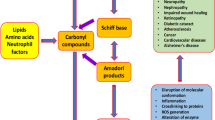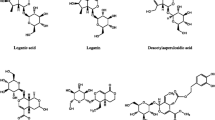Abstract
Since advanced glycation end-products (AGEs) inhibitors such as benfotiamine, pyridoxamine and aminoguanidine significantly inhibit the development of retinopathy and neuropathy in streptozotocin-induced diabetic rats, treatment with AGEs inhibitors is believed to be a potential strategy for preventing lifestyle-related diseases such as diabetic complications and atherosclerosis. Furthermore, preventive medicine is the most important approach to preventing lifestyle-related diseases, and improving daily nutritional intake is thought to prevent the pathogenesis of such diseases. Therefore, AGEs inhibitors that can be obtained from daily meals are preferred to prescribed drugs. In this article, we describe a strategy for developing new AGEs inhibitors from natural products.




Similar content being viewed by others
References
Ahmed MU, Thorpe SR, Baynes JW (1986) Identification of N epsiloncarboxymethyllysine as a degradation product of fructoselysine in glycated Protein. J Biol Chem 261:4889–4894
Ahmed MU, Brinkmann Frye E, Degenhardt TP, Thorpe SR, Baynes JW (1997) Nepsilon-(carboxyethyl)lysine, a product of the chemical modification of proteins by methylglyoxal, increases with age in human lens proteins. Biochem J 324:565–570
Akagawa M, Shigemitsu T, Suyama K (2005) Oxidative deamination of benzylamine and lysine residue in bovine serum albumin by green tea, black tea, and coffee. J Agric Food Chem 53:8019–8024
Argirov OK, Lin B, Ortwerth BJ (2004) 2-ammonio-6-(3-oxidopyridinium-1-yl)hexanoate (OP-lysine) is a newly identified advanced glycation end product in cataractous and aged human lenses. J Biol Chem 279:6487–6495
Avogaro A, Calo L, Piarulli F, Miola M, deKreutzenberg S, Maran A, Burlina A, Mingardi R, Tiengo A, Del Prato S (1999) Effect of acute ketosis on the endothelial function of type 1 diabetic patients: the role of nitric oxide. Diabetes 48:391–397
Degenhardt TP, Alderson NL, Arrington DD, Beattie RJ, Basgen JM, Steffes MW, Thorpe SR, Baynes JW (2002) Pyridoxamine inhibits early renal disease and dyslipidemia in the streptozotocindiabetic rat. Kidney Int 61:939–950
Frye EB, Degenhardt TP, Thorpe SR, Baynes JW (1998) Role of the Maillard reaction in aging of tissue proteins. Advanced glycation end product dependent increase in imidazolium cross-links in human lens proteins. J Biol Chem 273:18714–18719
Fujiwara Y, Kiyota N, Tsurushima K, Yoshitomi M, Mera K, Sakashita N, Takeya M, Ikeda T, Araki T, Nohara T, Nagai R (2011) Natural compounds containing a catechol group enhance the formation of Nε-(carboxymethyl)lysine of the Maillard reaction. Free Radical Biol Med 50:883–891
Furukawa A, Oikawa S, Murata M, Hiraku Y, Kawanishi S (2003) (-)-Epigallocatechin gallate causes oxidative damage to isolated and cellular DNA. Biochem Pharmacol 66:1769–1778
Hammes HP, Martin S, Federlin K, Geisen K, Brownlee M (1991) Aminoguanidine treatment inhibits the development of experimental diabetic retinopathy. Proc Natl Acad Sci USA 88:11555–11558
Hayase F, Nagaraj RH, Miyata S, Njoroge FG, Monnier VM (1989) Aging of proteins: immunological detection of a glucose-derived pyrrole formed during Maillard reaction in vivo. J Biol Chem 264:3758–3764
Hayashi MC, Nagai R, Miyazaki K, Hayase F, Araki T, Ono T, Horiuchi S (2002) Conversion of Amadori products of the Maillard reaction to N(epsilon)-(carboxymethyl)lysine by short-term heating: possible detection of artifacts by immunohistochemistry. Lab Invest 82(6):795–808
Ienaga K, Nakamura K, Hochi T, Nakazawa Y, Fukunaga Y, Kakita H, Nakano K (1995) Crosslines, fluorophores in the AGE-related cross-linked proteins. Contrib Nephrol 112:42–51
Jain SK, McVie R (1999) Hyperketonemia can increase lipid peroxidation and lower glutathione levels in human erythrocytes in vitro and in type 1 diabetic patients. Diabetes 48:1850–1855
Kume S, Takeya M, Mori T, Araki N, Suzuki H, Horiuchi S, Kodama T, Miyauchi Y, Takahashi K (1995) Immunohistochemical and ultrastructural detection of advanced glycation end products in atherosclerotic lesions of human aorta with a novel specific monoclonal antibody. Am J Pathol 147:654–667
Lebovitz HE (1995) Diabet ketoacidosis Lancet 345(8952):767–772
Lederer MO, Bühler HP (1999) Cross-linking of proteins by Maillard Processes-characterization and detection of a Lysine-Arginine cross-link derived from D-Glucose. Bioorg Med Chem 7:1081–1088
Maillard LC (1912) Action des acides amines sur les sucres: formation des melanoidines par voie methodique. C R Acad Sci Paris 154:66–68
Makino H, Shikata K, Hironaka K, Kushiro M, Yamasaki Y, Sugimoto H, Ota Z, Araki N, Horiuchi S (1995) Ultrastructure of nonenzymatically glycated mesangial matrix in diabetic nephropathy. Kidney Int 48:517–526
Mera K, Nagai R, Takeo K, Izami M, Maruyama T, Otagiri M (2011) An autoantibody against N(ε)-(carboxyethyl)lysine (CEL): possible involvement in the removal of CEL-modified proteins by macrophages. Biochem Biophys Res Commun 407:420–425
Mitchell GA, Kassovska-Bratinova S, Boukaftane Y, Robert MF, Wang SP, Ashmarina L, Lambert M, Lapierre P, Potier E (1995) Medical aspects of ketone body metabolism. Clin Invest Med 18:193–216
Miyata T, Ueda Y, Shinzato T, Tanaka S, Kurokawa K, van Ypersela de Strihou C, Maeda K (1996) Accumulation of albumin-linked and free-form pentosidine in the circulation of uremic patients with end-stage renal failure: renal implications in the pathophysiology of pentosidine. J Am Soc Nephrol 7:1198–1206
Motomura K, Fujiwara Y, Kiyota N, Tsurushima K, Takeya M, Nohara T, Nagai R, Ikeda T (2009) Astragalosides isolated from the root of astragalus radix inhibit the formation of advanced glycation end products. J Agric Food Chem 57:7666–7672
Murata T, Nagai R, Ishibashi T, Inomuta H, Ikeda K, Horiuchi S (1997) The relationship between accumulation of advanced glycation end products and expression of vascular endothelial growth factor in human diabetic retinas. Diabetologia 40:764–769
Nagai R, Hayashi CM, Xia L, Takeya M, Horiuchi S (2002) Identification in human atherosclerotic lesions of GA-pyridine, a novel structure derived from glycolaldehyde-modified proteins. J Biol Chem 277:48905–48912
Nagai R, Nagai M, Shimasaki S, Baynes JW, Fujiwara Y (2010a) Citric acid inhibits development of cataracts, proteinuria and ketosis in streptozotocin (type 1) diabetic rats. Biochem Biophys Res Commun 393:118–122
Nagai R, Mori T, Yamamoto Y, Kaji Y, Yonei Y (2010b) Significance of advanced glycation end products in aging-related disease. Anti-Aging Med 7(10):112–119
Nakano M, Kubota M, Owada S, Nagai R (2011) The pentosidine concentration in human blood specimens is affected by heating. Amino Acids [Epub ahead of print]
Sakata N, Imanaga Y, Meng J, Tachikawa Y, Takebayashi S, Nagai R, Horiuchi S (1999) Increased advanced glycation end products in atherosclerotic lesions of patients with end-stage renal disease. Atherosclerosis 142:67–77
Sanaka T, Funaki T, Tanaka T, Hoshi S, Niwayama J, Taitoh T, Nishimura H, Higuchi C (2002) Plasma pentosidine levels measured by a newly developed method using ELISA in patients with chronic renal failure. Nephron 91:64–73
Sell DR, Monnier VM (1989) Structure elucidation of a senescence cross-link from human extracellular matrix. Implication of pentoses in the aging process. J Biol Chem 264:21597–21602
Shibayama R, Araki N, Nagai R, Horiuchi S (1999) Autoantibody against N(epsilon)-(carboxymethyl)lysine: an advanced glycation end product of the Maillard reaction. Diabetes 48:1842–1849
Suzuki D, Yagame M, Jinde K, Naka R, Yano N, Endoh M, Kaneshige H, Nomoto Y, Sakai H (1996) Immunofluorescence staining of renal biopsy samples in patients with diabetic nephropathy in non-insulin-dependent diabetes mellitus using monoclonal antibody to reduced glycated lysine. J Diabetes Complications 10:314–319
Thornalley PJ, Battah S, Ahmed N, Karachalias N, Agalou S, Babaei-Jadidi R, Dawnay A (2003) Quantitative screening of advanced glycation end products in cellular and extracellular proteins by tandem mass spectrometry. Biochem J. 375(Pt 3):581–592
Vignati L (1985) Insulin pumps: when are they indicated, what can they do? Trans Assoc Life Insur Med Dir Am 68:53–60
Acknowledgments
This work was supported in part by Grants-in-Aid for Scientific Research (No. 24300260 and 24650482 to Ryoji Nagai) from the Ministry of Education, Science, Sports and Culture of Japan.
Author information
Authors and Affiliations
Corresponding author
Rights and permissions
About this article
Cite this article
Nagai, R., Shirakawa, Ji., Ohno, Ri. et al. Inhibition of AGEs formation by natural products. Amino Acids 46, 261–266 (2014). https://doi.org/10.1007/s00726-013-1487-z
Received:
Accepted:
Published:
Issue Date:
DOI: https://doi.org/10.1007/s00726-013-1487-z




